The Cambridge History of Japan, Vol. 3: Medieval Japan
Подождите немного. Документ загружается.

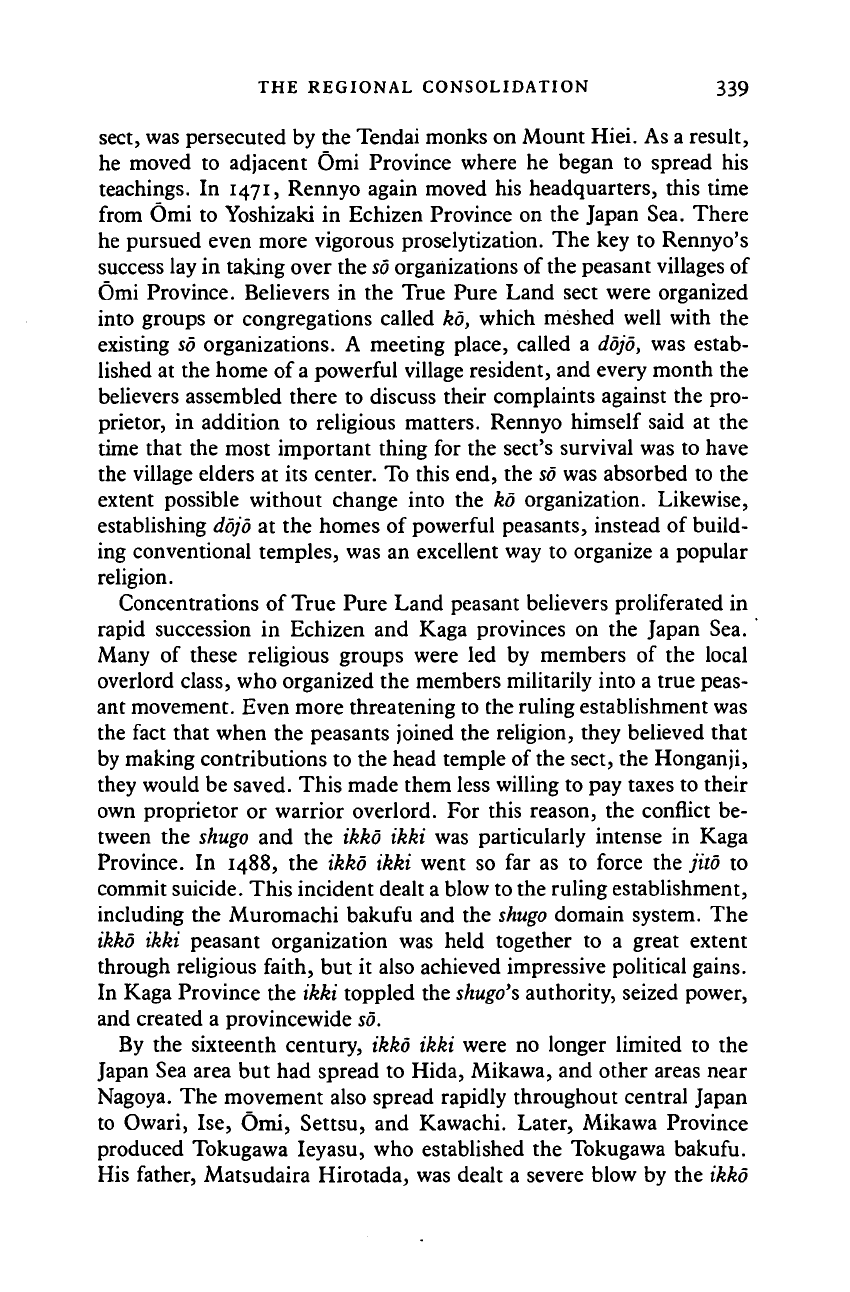
THE REGIONAL CONSOLIDATION 339
sect, was persecuted by the Tendai monks on Mount Hiei. As a result,
he moved to adjacent Omi Province where he began to spread his
teachings. In 1471, Rennyo again moved his headquarters, this time
from Omi to Yoshizaki in Echizen Province on the Japan Sea. There
he pursued even more vigorous proselytization. The key to Rennyo's
success lay in taking over the
sd
organizations of the peasant villages of
Omi Province. Believers in the True Pure Land sect were organized
into groups or congregations called ko, which meshed well with the
existing so organizations. A meeting place, called a dqjo, was estab-
lished at the home of a powerful village resident, and every month the
believers assembled there to discuss their complaints against the pro-
prietor, in addition to religious matters. Rennyo himself said at the
time that the most important thing for the sect's survival was to have
the village elders at its center. To this end, the so was absorbed to the
extent possible without change into the ko organization. Likewise,
establishing dqjo at the homes of powerful peasants, instead of build-
ing conventional temples, was an excellent way to organize a popular
religion.
Concentrations of True Pure Land peasant believers proliferated in
rapid succession in Echizen and Kaga provinces on the Japan Sea.
Many of these religious groups were led by members of the local
overlord class, who organized the members militarily into a true peas-
ant movement. Even more threatening to the ruling establishment was
the fact that when the peasants joined the religion, they believed that
by making contributions to the head temple of the sect, the Honganji,
they would be saved. This made them less willing to pay taxes to their
own proprietor or warrior overlord. For this reason, the conflict be-
tween the shugo and the ikko ikki was particularly intense in Kaga
Province. In 1488, the ikko ikki went so far as to force the jito to
commit suicide. This incident dealt a blow to the ruling establishment,
including the Muromachi bakufu and the shugo domain system. The
ikko ikki peasant organization was held together to a great extent
through religious faith, but it also achieved impressive political gains.
In Kaga Province the ikki toppled the shugo's authority, seized power,
and created a provincewide so.
By the sixteenth century, ikko ikki were no longer limited to the
Japan Sea area but had spread to Hida, Mikawa, and other areas near
Nagoya. The movement also spread rapidly throughout central Japan
to Owari, Ise, Omi, Settsu, and Kawachi. Later, Mikawa Province
produced Tokugawa Ieyasu, who established the Tokugawa bakufu.
His father, Matsudaira Hirotada, was dealt a severe blow by the ikko
Cambridge Histories Online © Cambridge University Press, 2008
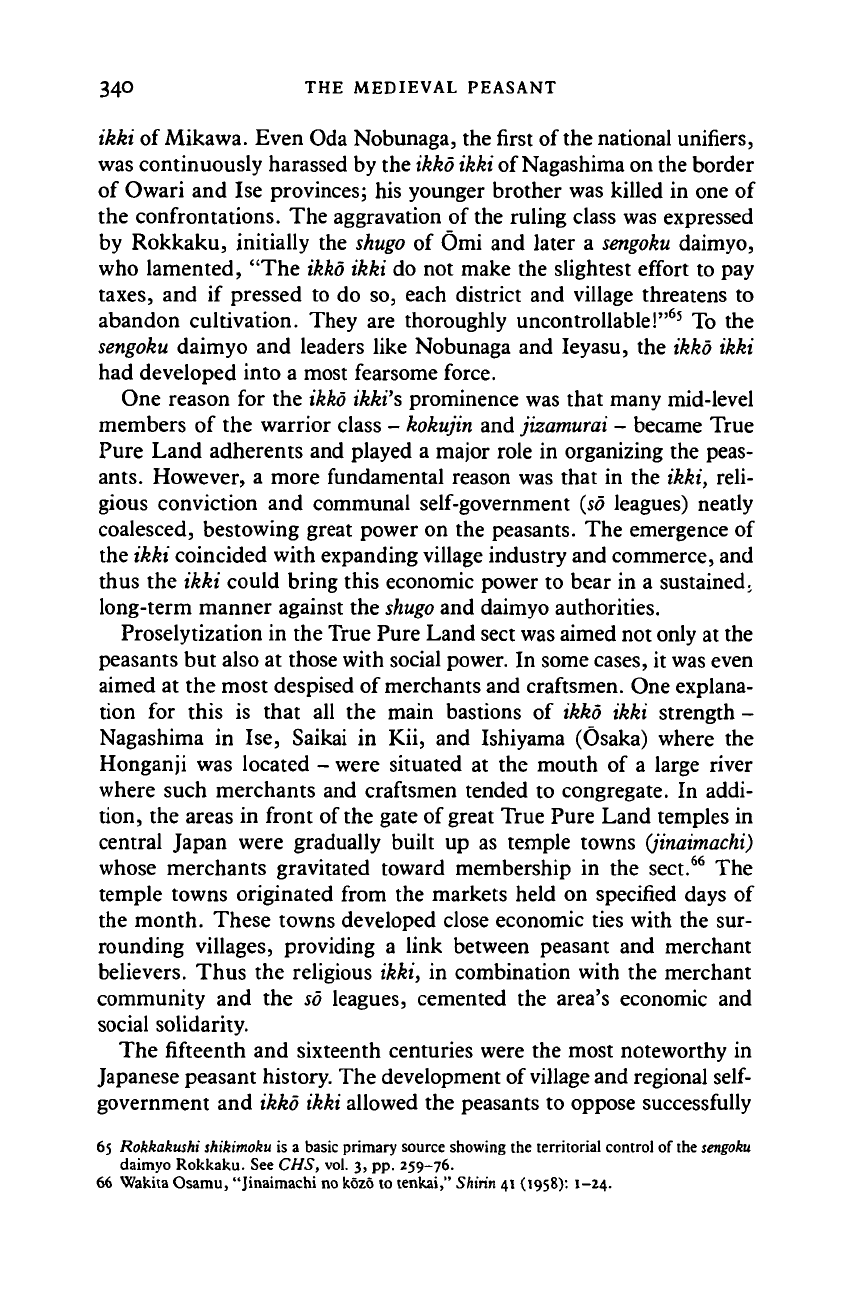
34° THE MEDIEVAL PEASANT
ikki of
Mikawa.
Even Oda Nobunaga, the first of
the
national unifiers,
was continuously harassed by the
ikko
ikki of Nagashima on the border
of Owari and Ise provinces; his younger brother was killed in one of
the confrontations. The aggravation of the ruling class was expressed
by Rokkaku, initially the
shugo
of Omi and later a
sengoku
daimyo,
who lamented, "The ikko ikki do not make the slightest effort to pay
taxes,
and if pressed to do so, each district and village threatens to
abandon cultivation. They are thoroughly uncontrollable!"
65
To the
sengoku
daimyo and leaders like Nobunaga and Ieyasu, the ikko ikki
had developed into a most fearsome force.
One reason for the ikko ikki's prominence was that many mid-level
members of the warrior class -
kokujin
and
jizamurai
- became True
Pure Land adherents and played a major role in organizing the peas-
ants.
However, a more fundamental reason was that in the ikki, reli-
gious conviction and communal self-government (so leagues) neatly
coalesced, bestowing great power on the peasants. The emergence of
the ikki coincided with expanding village industry and commerce, and
thus the ikki could bring this economic power to bear in a sustained.
long-term manner against the
shugo
and daimyo authorities.
Proselytization in the True Pure Land sect was aimed not only at the
peasants but also at those with social power. In some cases, it was even
aimed at the most despised of merchants and craftsmen. One explana-
tion for this is that all the main bastions of ikko ikki strength -
Nagashima in Ise, Saikai in Kii, and Ishiyama (Osaka) where the
Honganji was located - were situated at the mouth of a large river
where such merchants and craftsmen tended to congregate. In addi-
tion, the areas in front of the gate of great True Pure Land temples in
central Japan were gradually built up as temple towns
(jinaimachi)
whose merchants gravitated toward membership in the sect.
66
The
temple towns originated from the markets held on specified days of
the month. These towns developed close economic ties with the sur-
rounding villages, providing a link between peasant and merchant
believers. Thus the religious ikki, in combination with the merchant
community and the so leagues, cemented the area's economic and
social solidarity.
The fifteenth and sixteenth centuries were the most noteworthy in
Japanese peasant history. The development of village and regional
self-
government and ikko ikki allowed the peasants to oppose successfully
65 Rokkakushi shikimoku is a basic primary source showing the territorial control of the
sengoku
daimyo Rokkaku. See CHS, vol. 3, pp. 259-76.
66 Wakita Osamu, "Jinaimachi no kozo to tenkai," Shirin 41 (1958): 1-24.
Cambridge Histories Online © Cambridge University Press, 2008
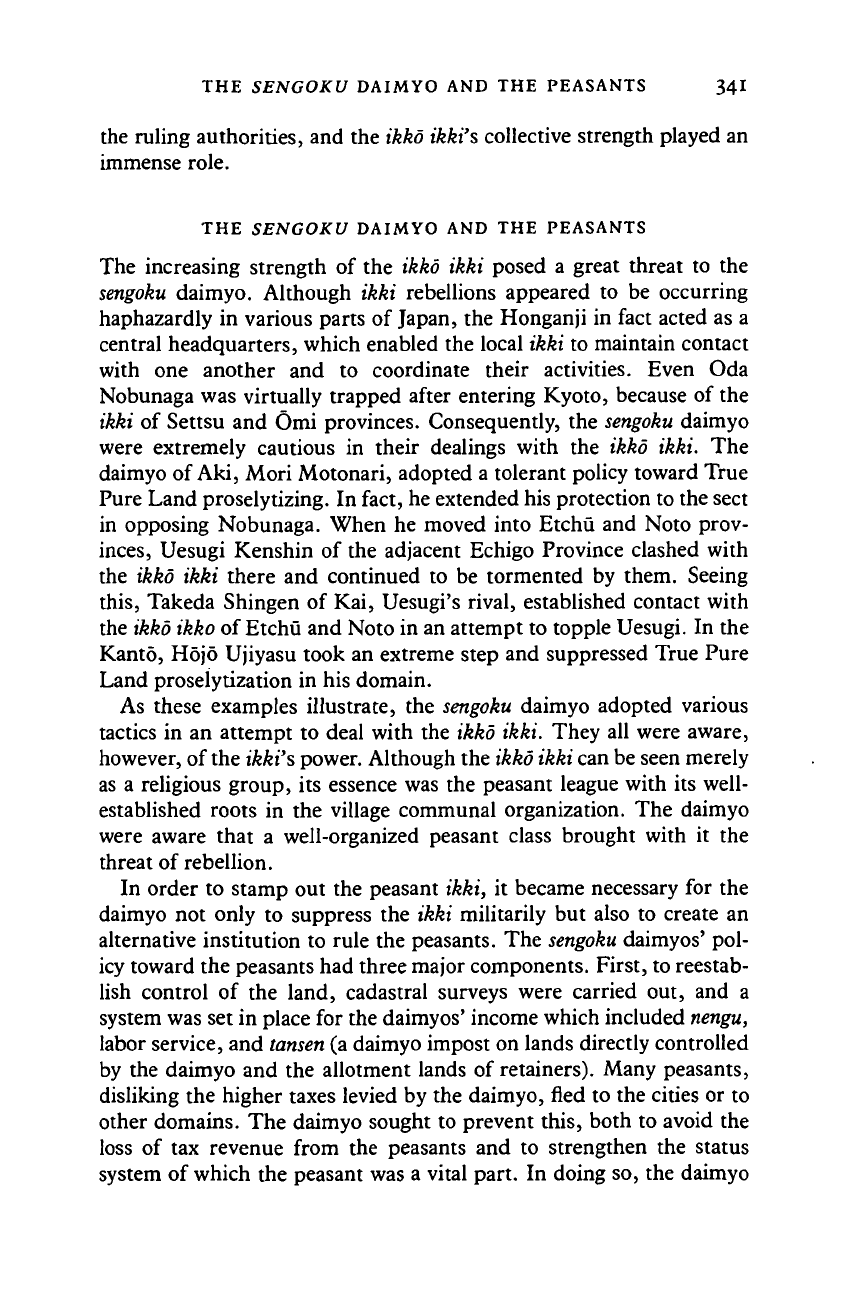
THE SENGOKU DAIMYO AND THE PEASANTS 34I
the ruling authorities, and the ikkd ikki's collective strength played an
immense role.
THE SENGOKU DAIMYO AND THE PEASANTS
The increasing strength of the ikkd ikki posed a great threat to the
sengoku daimyo. Although ikki rebellions appeared to be occurring
haphazardly in various parts of Japan, the Honganji in fact acted as a
central headquarters, which enabled the local ikki to maintain contact
with one another and to coordinate their activities. Even Oda
Nobunaga was virtually trapped after entering Kyoto, because of the
ikki of Settsu and Omi provinces. Consequently, the sengoku daimyo
were extremely cautious in their dealings with the ikkd ikki. The
daimyo of Aki, Mori Motonari, adopted a tolerant policy toward True
Pure Land proselytizing. In fact, he extended his protection to the sect
in opposing Nobunaga. When he moved into Etchu and Noto prov-
inces,
Uesugi Kenshin of the adjacent Echigo Province clashed with
the ikkd ikki there and continued to be tormented by them. Seeing
this,
Takeda Shingen of Kai, Uesugi's rival, established contact with
the ikkd ikko of Etchu and Noto in an attempt to topple Uesugi. In the
Kanto, Hojo Ujiyasu took an extreme step and suppressed True Pure
Land proselytization in his domain.
As these examples illustrate, the sengoku daimyo adopted various
tactics in an attempt to deal with the ikkd ikki. They all were aware,
however, of the ikki's power. Although the ikkd ikki can be seen merely
as a religious group, its essence was the peasant league with its well-
established roots in the village communal organization. The daimyo
were aware that a well-organized peasant class brought with it the
threat of rebellion.
In order to stamp out the peasant ikki, it became necessary for the
daimyo not only to suppress the ikki militarily but also to create an
alternative institution to rule the peasants. The sengoku daimyos' pol-
icy toward the peasants had three major components. First, to reestab-
lish control of the land, cadastral surveys were carried out, and a
system was set in place for the daimyos' income which included nengu,
labor service, and tansen (a daimyo impost on lands directly controlled
by the daimyo and the allotment lands of retainers). Many peasants,
disliking the higher taxes levied by the daimyo, fled to the cities or to
other domains. The daimyo sought to prevent this, both to avoid the
loss of tax revenue from the peasants and to strengthen the status
system of which the peasant was a vital part. In doing so, the daimyo
Cambridge Histories Online © Cambridge University Press, 2008
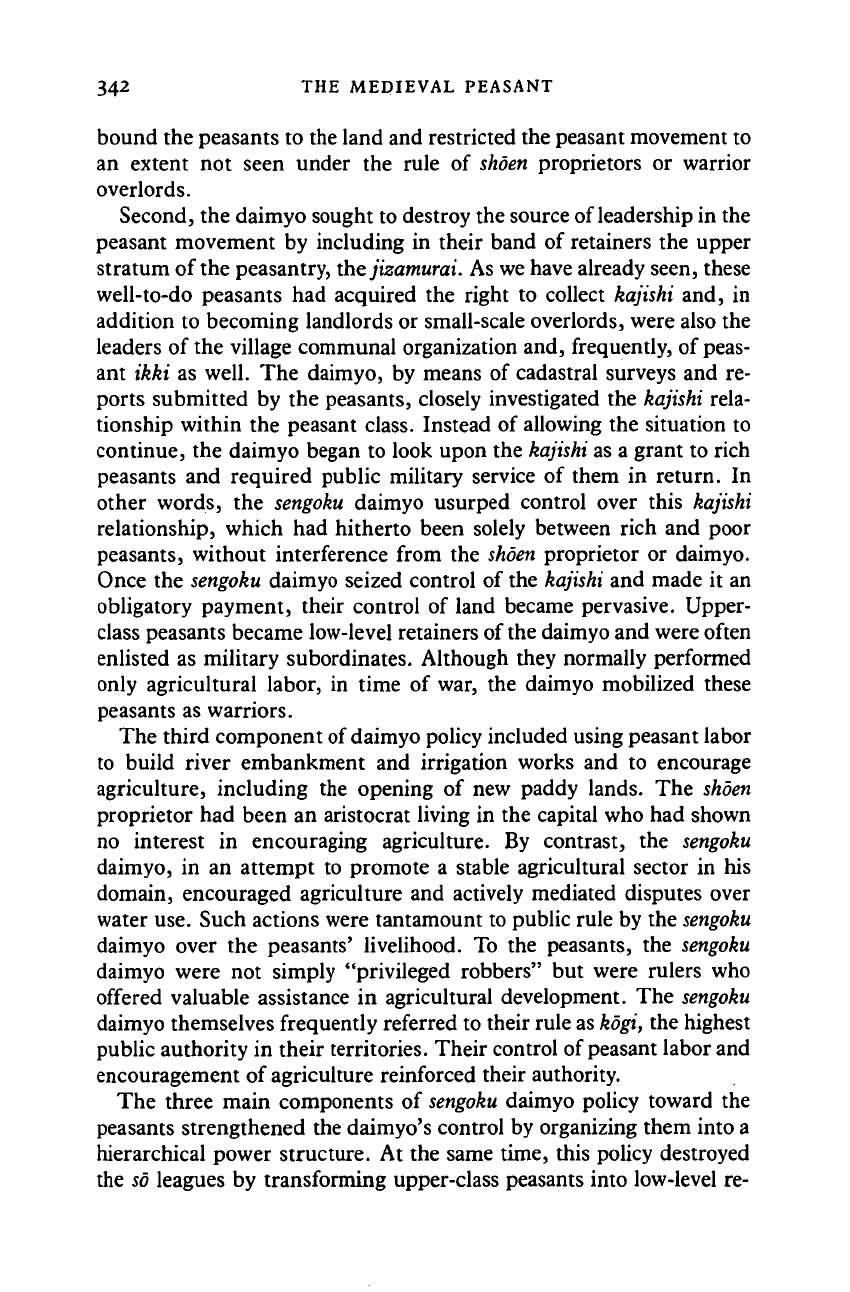
342 THE MEDIEVAL PEASANT
bound the peasants to the land and restricted the peasant movement to
an extent not seen under the rule of
shoen
proprietors or warrior
overlords.
Second, the daimyo sought to destroy the source of leadership in the
peasant movement by including in their band of retainers the upper
stratum of the peasantry, the
jizamurai.
As we have already seen, these
well-to-do peasants had acquired the right to collect kajishi and, in
addition to becoming landlords or small-scale overlords, were also the
leaders of the village communal organization and, frequently, of peas-
ant ikki as well. The daimyo, by means of cadastral surveys and re-
ports submitted by the peasants, closely investigated the
kajishi
rela-
tionship within the peasant class. Instead of allowing the situation to
continue, the daimyo began to look upon the
kajishi
as a grant to rich
peasants and required public military service of them in return. In
other words, the
sengoku
daimyo usurped control over this kajishi
relationship, which had hitherto been solely between rich and poor
peasants, without interference from the
shoen
proprietor or daimyo.
Once the
sengoku
daimyo seized control of the
kajishi
and made it an
obligatory payment, their control of land became pervasive. Upper-
class peasants became low-level retainers of
the
daimyo and were often
enlisted as military subordinates. Although they normally performed
only agricultural labor, in time of war, the daimyo mobilized these
peasants as warriors.
The third component of daimyo policy included using peasant labor
to build river embankment and irrigation works and to encourage
agriculture, including the opening of new paddy lands. The
shoen
proprietor had been an aristocrat living in the capital who had shown
no interest in encouraging agriculture. By contrast, the sengoku
daimyo, in an attempt to promote a stable agricultural sector in his
domain, encouraged agriculture and actively mediated disputes over
water use. Such actions were tantamount to public rule by the
sengoku
daimyo over the peasants' livelihood. To the peasants, the
sengoku
daimyo were not simply "privileged robbers" but were rulers who
offered valuable assistance in agricultural development. The
sengoku
daimyo themselves frequently referred to their rule as
kogi,
the highest
public authority in their territories. Their control of peasant labor and
encouragement of agriculture reinforced their authority.
The three main components of
sengoku
daimyo policy toward the
peasants strengthened the daimyo's control by organizing them into a
hierarchical power structure. At the same time, this policy destroyed
the
so
leagues by transforming upper-class peasants into low-level re-
Cambridge Histories Online © Cambridge University Press, 2008
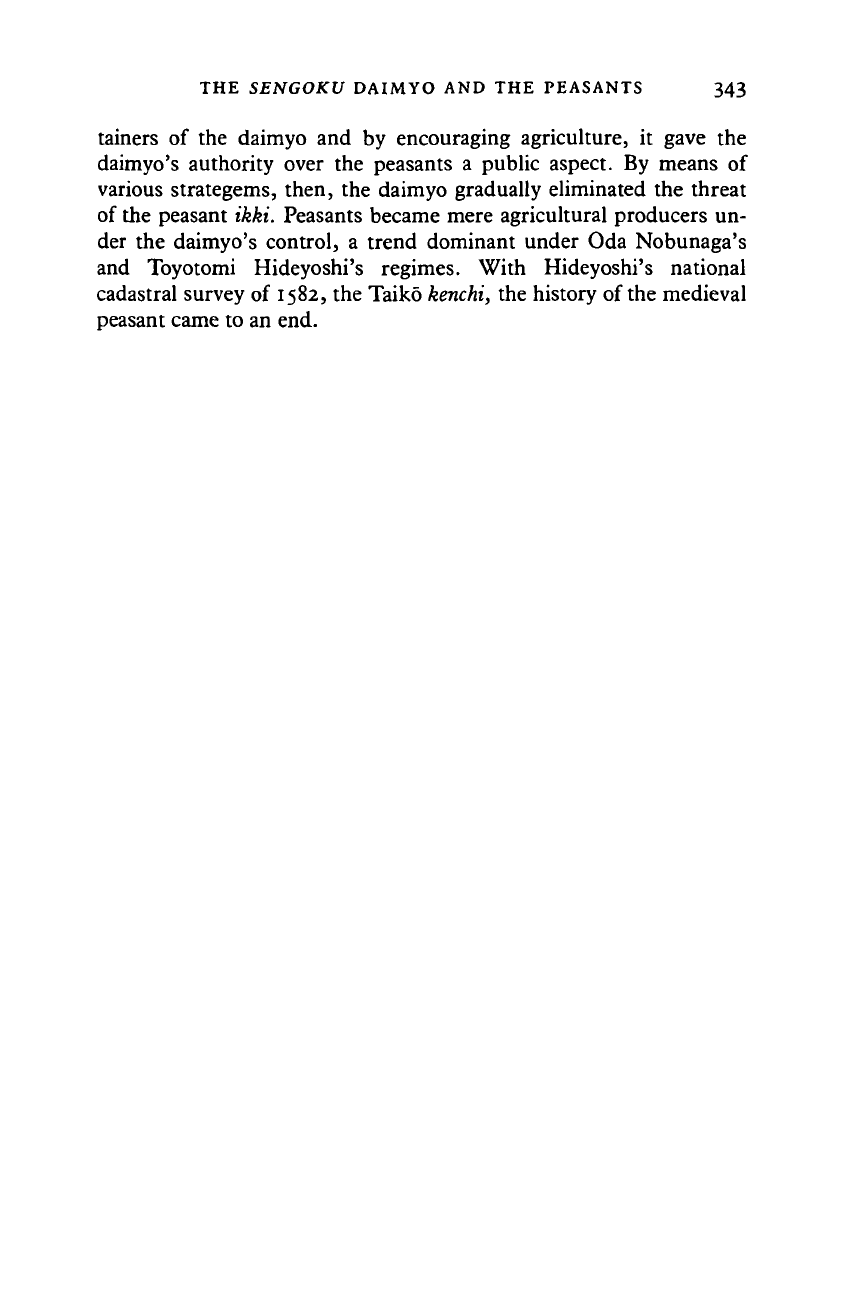
THE SENGOKU DAIMYO AND THE PEASANTS 343
tainers of the daimyo and by encouraging agriculture, it gave the
daimyo's authority over the peasants a public aspect. By means of
various strategems, then, the daimyo gradually eliminated the threat
of the peasant ikki. Peasants became mere agricultural producers un-
der the daimyo's control, a trend dominant under Oda Nobunaga's
and Toyotomi Hideyoshi's regimes. With Hideyoshi's national
cadastral survey of 1582, the Taiko
kenchi,
the history of the medieval
peasant came to an end.
Cambridge Histories Online © Cambridge University Press, 2008
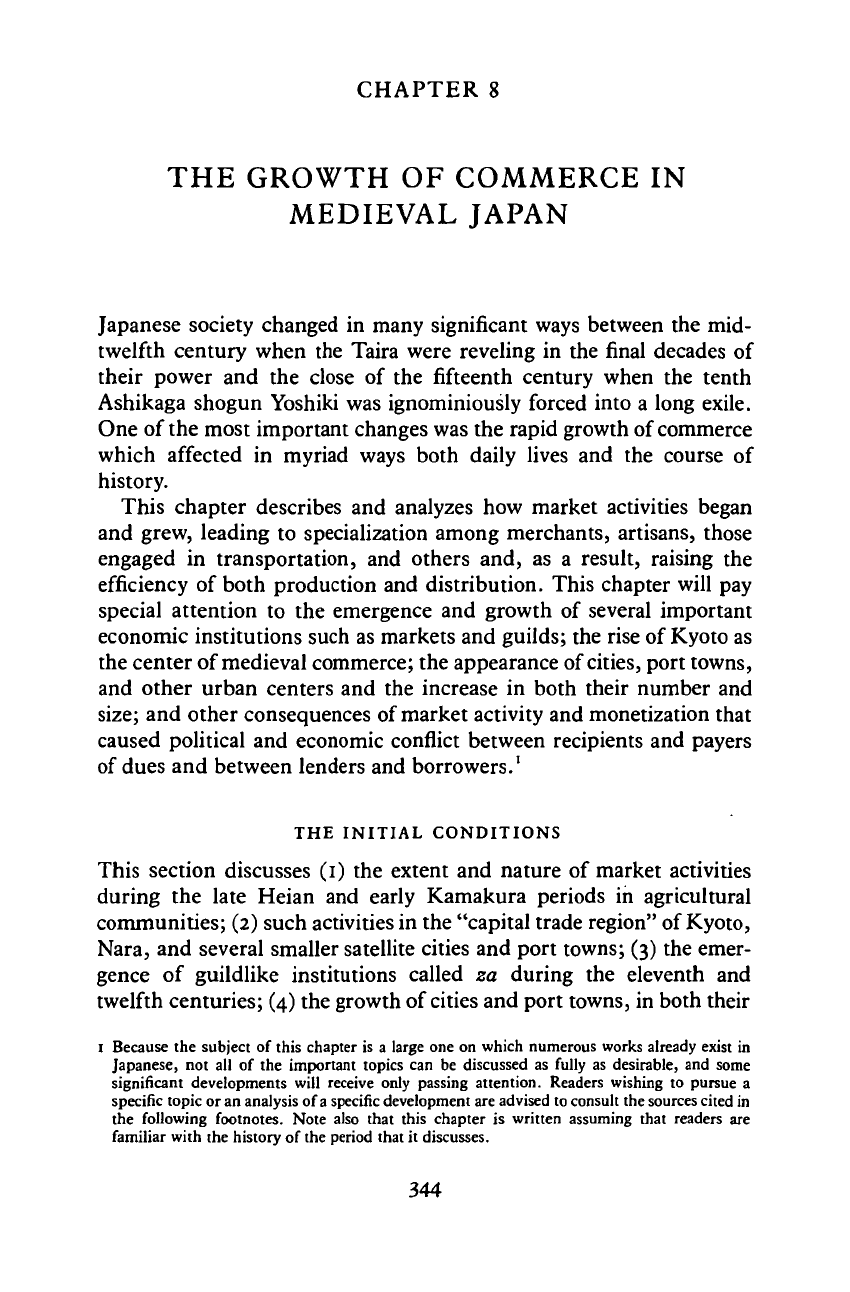
CHAPTER
8
THE GROWTH OF COMMERCE
IN
MEDIEVAL JAPAN
Japanese society changed
in
many significant ways between the mid-
twelfth century when the Taira were reveling in the final decades of
their power and
the
close
of
the fifteenth century when
the
tenth
Ashikaga shogun Yoshiki was ignominiously forced into
a
long exile.
One of the most important changes was the rapid growth of commerce
which affected
in
myriad ways both daily lives and
the
course
of
history.
This chapter describes and analyzes how market activities began
and grew, leading to specialization among merchants, artisans, those
engaged
in
transportation, and others and,
as a
result, raising
the
efficiency of both production and distribution. This chapter will pay
special attention
to
the emergence and growth
of
several important
economic institutions such as markets and guilds; the rise of Kyoto as
the center of medieval commerce; the appearance of
cities,
port towns,
and other urban centers and the increase
in
both their number and
size;
and other consequences of market activity and monetization that
caused political and economic conflict between recipients and payers
of dues and between lenders and borrowers.
1
THE INITIAL CONDITIONS
This section discusses (i) the extent and nature
of
market activities
during
the
late Heian and early Kamakura periods
in
agricultural
communities; (2) such activities in the "capital trade region" of Kyoto,
Nara, and several smaller satellite cities and port towns; (3) the emer-
gence
of
guildlike institutions called
za
during
the
eleventh
and
twelfth centuries; (4) the growth of
cities
and port towns, in both their
1 Because the subject of this chapter
is a
large one on which numerous works already exist
in
Japanese,
not all of
the important topics can
be
discussed
as
fully
as
desirable, and some
significant developments will receive only passing attention. Readers wishing
to
pursue
a
specific topic or an analysis of a specific development are advised to consult the sources cited in
the following footnotes. Note also that this chapter
is
written assuming that readers
are
familiar with the history of the period that it discusses.
344
Cambridge Histories Online © Cambridge University Press, 2008
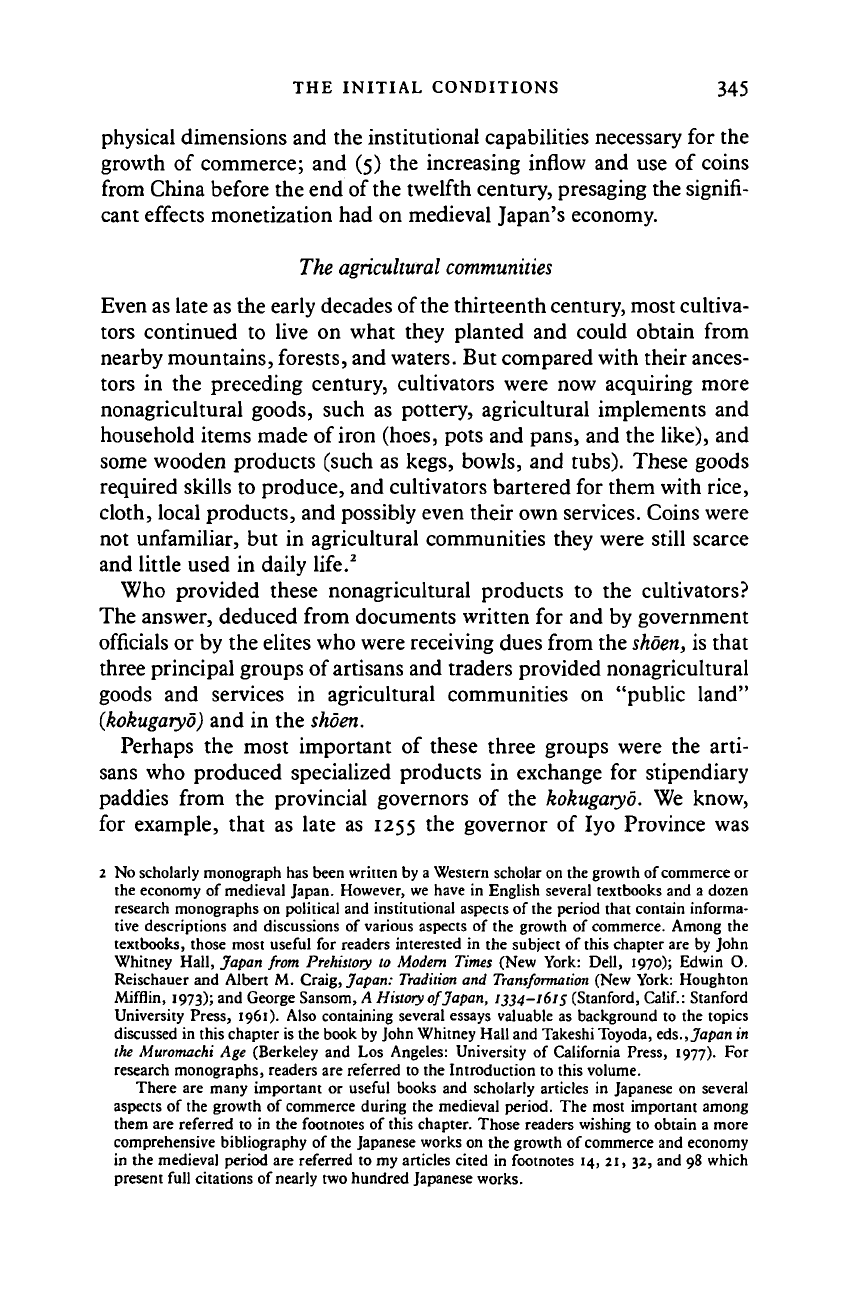
THE INITIAL CONDITIONS 345
physical dimensions and the institutional capabilities necessary for the
growth of commerce; and (5) the increasing inflow and use of coins
from China before the end of the twelfth century, presaging the signifi-
cant effects monetization had on medieval Japan's economy.
The
agricultural communities
Even as late as the early decades of the thirteenth century, most cultiva-
tors continued to live on what they planted and could obtain from
nearby mountains, forests, and waters. But compared with their ances-
tors in the preceding century, cultivators were now acquiring more
nonagricultural goods, such as pottery, agricultural implements and
household items made of iron (hoes, pots and pans, and the like), and
some wooden products (such as kegs, bowls, and tubs). These goods
required skills to produce, and cultivators bartered for them with rice,
cloth, local products, and possibly even their own services. Coins were
not unfamiliar, but in agricultural communities they were still scarce
and little used in daily life.
2
Who provided these nonagricultural products to the cultivators?
The answer, deduced from documents written for and by government
officials or by the elites who were receiving dues from the
shoen,
is that
three principal groups of artisans and traders provided nonagricultural
goods and services in agricultural communities on "public land"
{kokugaryo)
and in the shoen.
Perhaps the most important of these three groups were the arti-
sans who produced specialized products in exchange for stipendiary
paddies from the provincial governors of the kokugaryo. We know,
for example, that as late as 1255 the governor of Iyo Province was
2 No scholarly monograph has been written by a Western scholar on the growth of commerce or
the economy of medieval Japan. However, we have in English several textbooks and a dozen
research monographs on political and institutional aspects of the period that contain informa-
tive descriptions and discussions of various aspects of the growth of commerce. Among the
textbooks, those most useful for readers interested in the subject of this chapter are by John
Whitney Hall, Japan from Prehistory to Modem Times (New York: Dell, 1970); Edwin O.
Reischauer and Albert M. Craig, Japan: Tradition and
Transformation
(New York: Houghton
Mifflin, 1973); and George Sansom, A History of Japan, 1334-161 s (Stanford,
Calif.:
Stanford
University Press, 1961). Also containing several essays valuable as background to the topics
discussed in this chapter is the book by John Whitney Hall and Takeshi Toyoda,
eds.,
Japan in
the Muromachi Age (Berkeley and Los Angeles: University of California Press, 1977). For
research monographs, readers are referred to the Introduction to this volume.
There are many important or useful books and scholarly articles in Japanese on several
aspects of the growth of commerce during the medieval period. The most important among
them are referred to in the footnotes of this chapter. Those readers wishing to obtain a more
comprehensive bibliography of the Japanese works on the growth of commerce and economy
in the medieval period are referred to my articles cited in footnotes 14, 21, 32, and 98 which
present full citations of nearly two hundred Japanese works.
Cambridge Histories Online © Cambridge University Press, 2008
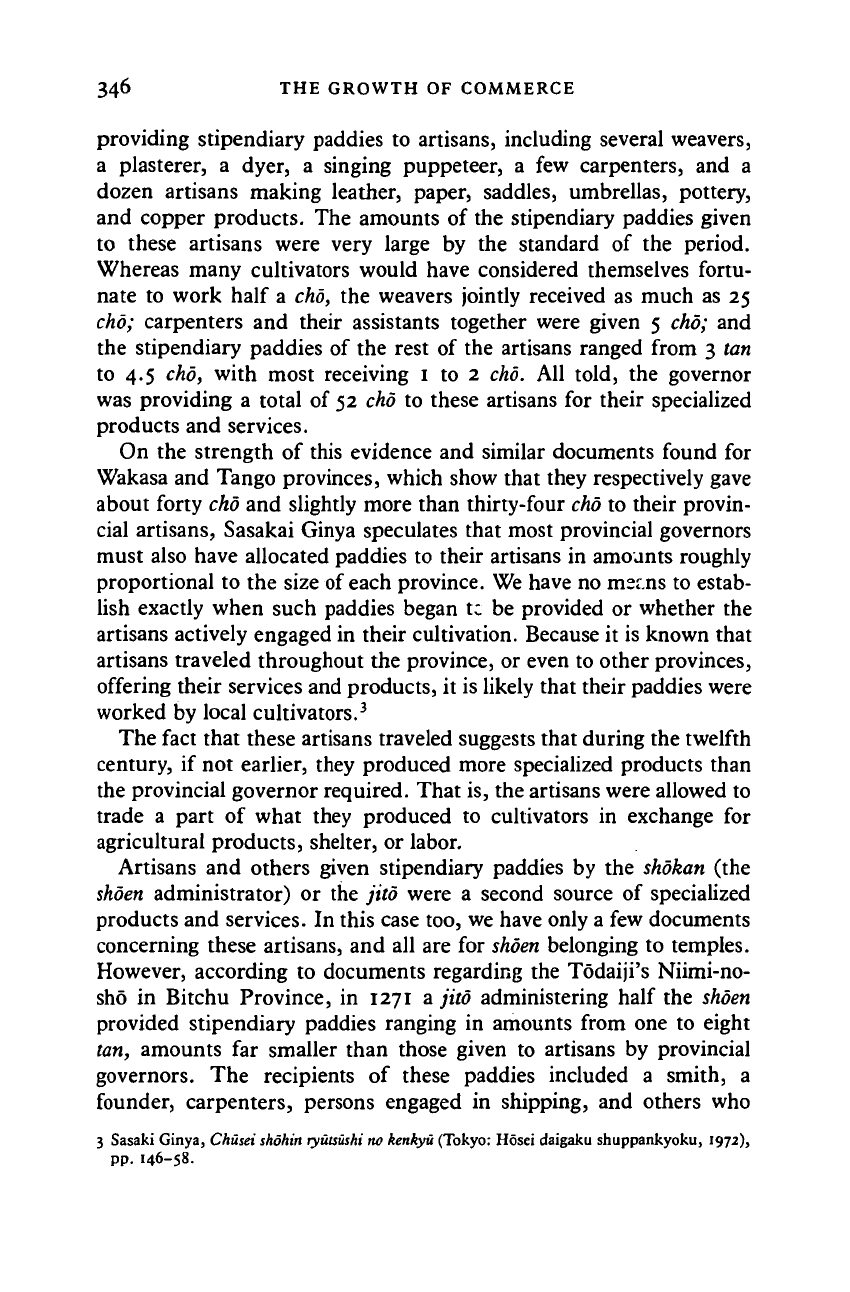
346 THE GROWTH OF COMMERCE
providing stipendiary paddies to artisans, including several weavers,
a plasterer, a dyer, a singing puppeteer, a few carpenters, and a
dozen artisans making leather, paper, saddles, umbrellas, pottery,
and copper products. The amounts of the stipendiary paddies given
to these artisans were very large by the standard of the period.
Whereas many cultivators would have considered themselves fortu-
nate to work half a
cho,
the weavers jointly received as much as 25
cho;
carpenters and their assistants together were given 5 cho; and
the stipendiary paddies of the rest of the artisans ranged from 3 tan
to 4.5 cho, with most receiving 1 to 2 cho. All told, the governor
was providing a total of 52 cho to these artisans for their specialized
products and services.
On the strength of this evidence and similar documents found for
Wakasa and Tango provinces, which show that they respectively gave
about forty
cho
and slightly more than thirty-four
cho
to their provin-
cial artisans, Sasakai Ginya speculates that most provincial governors
must also have allocated paddies to their artisans in amounts roughly
proportional to the size of each province. We have no mscns to estab-
lish exactly when such paddies began tc be provided or whether the
artisans actively engaged in their cultivation. Because it is known that
artisans traveled throughout the province, or even to other provinces,
offering their services and products, it is likely that their paddies were
worked by local cultivators.
3
The fact that these artisans traveled suggests that during the twelfth
century, if not earlier, they produced more specialized products than
the provincial governor required. That is, the artisans were allowed to
trade a part of what they produced to cultivators in exchange for
agricultural products, shelter, or labor.
Artisans and others given stipendiary paddies by the shokan (the
shoen
administrator) or the jito were a second source of specialized
products and services. In this case too, we have only a few documents
concerning these artisans, and all are for
shoen
belonging to temples.
However, according to documents regarding the Todaiji's Niimi-no-
sho in Bitchu Province, in 1271 a jito administering half the
shoen
provided stipendiary paddies ranging in amounts from one to eight
tan,
amounts far smaller than those given to artisans by provincial
governors. The recipients of these paddies included a smith, a
founder, carpenters, persons engaged in shipping, and others who
3 Sasaki Ginya, Chusei shohin
ryutsushi
no kenkyu (Tokyo: Hosei daigaku shuppankyoku, 1972),
pp.
146-58.
Cambridge Histories Online © Cambridge University Press, 2008
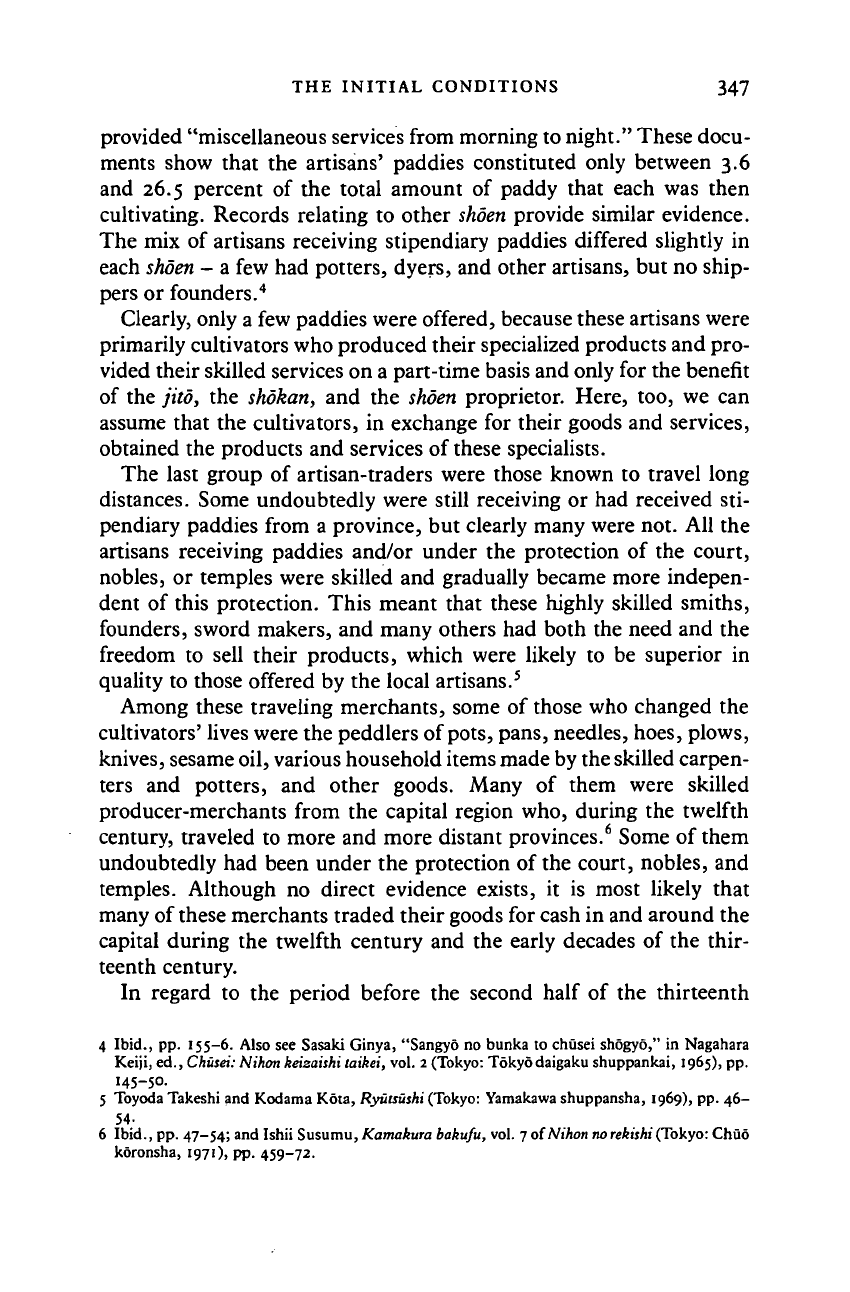
THE INITIAL CONDITIONS 347
provided "miscellaneous services from morning to night." These docu-
ments show that the artisans' paddies constituted only between 3.6
and 26.5 percent of the total amount of paddy that each was then
cultivating. Records relating to other shoen provide similar evidence.
The mix of artisans receiving stipendiary paddies differed slightly in
each shoen - a few had potters, dyers, and other artisans, but no ship-
pers or founders.
4
Clearly, only a few paddies were offered, because these artisans were
primarily cultivators who produced their specialized products and pro-
vided their skilled services on a part-time basis and only for the benefit
of the jito, the shokan, and the shoen proprietor. Here, too, we can
assume that the cultivators, in exchange for their goods and services,
obtained the products and services of these specialists.
The last group of artisan-traders were those known to travel long
distances. Some undoubtedly were still receiving or had received sti-
pendiary paddies from a province, but clearly many were not. All the
artisans receiving paddies and/or under the protection of the court,
nobles, or temples were skilled and gradually became more indepen-
dent of this protection. This meant that these highly skilled smiths,
founders, sword makers, and many others had both the need and the
freedom to sell their products, which were likely to be superior in
quality to those offered by the local artisans.
5
Among these traveling merchants, some of those who changed the
cultivators' lives were the peddlers of
pots,
pans, needles, hoes, plows,
knives, sesame oil, various household items made by the skilled carpen-
ters and potters, and other goods. Many of them were skilled
producer-merchants from the capital region who, during the twelfth
century, traveled to more and more distant provinces.
6
Some of them
undoubtedly had been under the protection of the court, nobles, and
temples. Although no direct evidence exists, it is most likely that
many of these merchants traded their goods for cash in and around the
capital during the twelfth century and the early decades of the thir-
teenth century.
In regard to the period before the second half of the thirteenth
4 Ibid., pp. 155-6. Also see Sasaki Ginya, "Sangyo no bunka to chusei shogyo," in Nagahara
Keiji, ed., Chusei: Nihon keizaishi laikei, vol. 2 (Tokyo: Tokyo daigaku shuppankai, 1965), pp.
145-50.
5 Toyoda Takeshi and Kodama Kota, Ryutsushi (Tokyo: Yamakawa shuppansha, 1969), pp. 46-
54-
6 Ibid., pp. 47-54; and Ishii Susumu, Kamakura bakufu, vol. 7 of Nihon
no rekishi
(Tokyo:
Chuo
kdronsha, 1971), pp. 459-72.
Cambridge Histories Online © Cambridge University Press, 2008
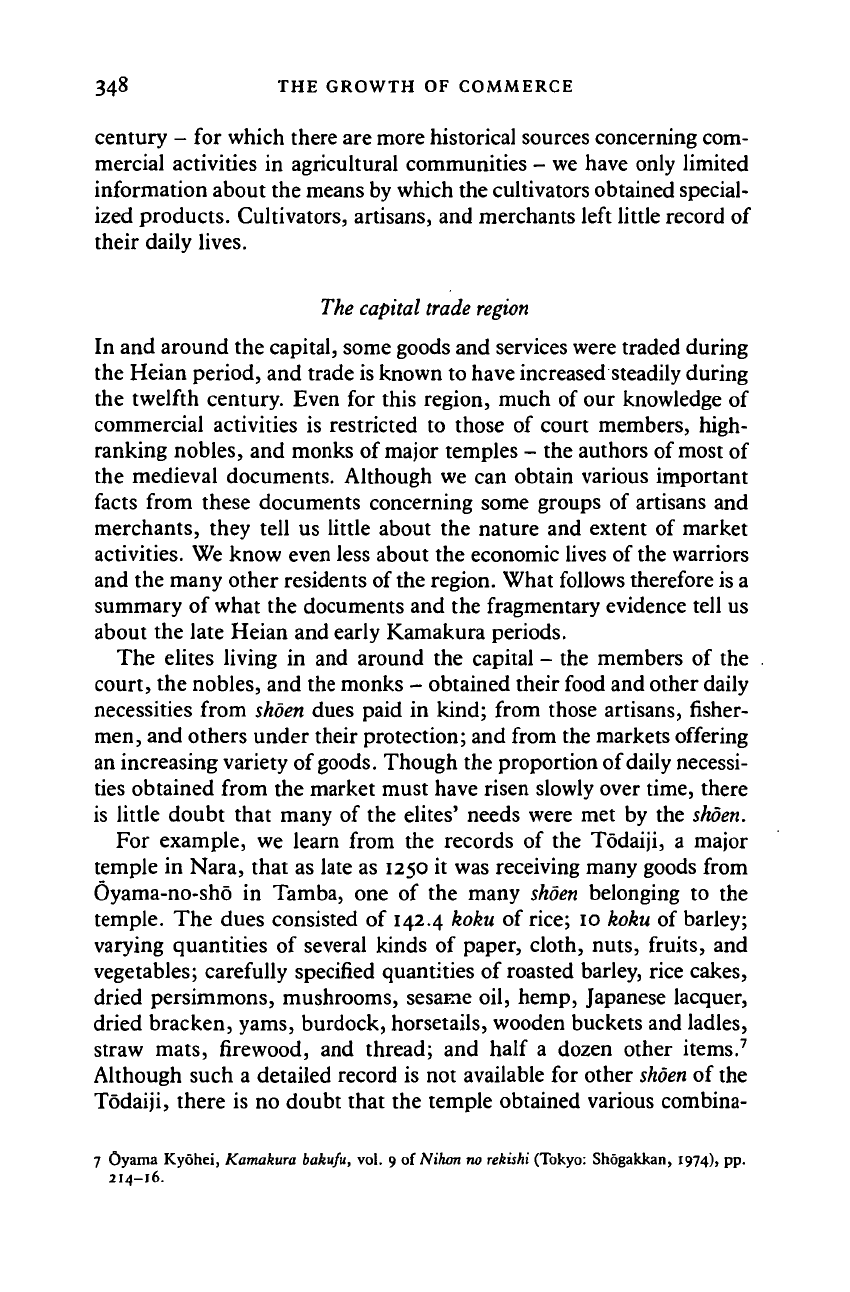
348 THE GROWTH OF COMMERCE
century - for which there are more historical sources concerning com-
mercial activities in agricultural communities - we have only limited
information about the means by which the cultivators obtained special-
ized products. Cultivators, artisans, and merchants left little record of
their daily lives.
The capital trade
region
In and around the capital, some goods and services were traded during
the Heian period, and trade is known to have increased steadily during
the twelfth century. Even for this region, much of our knowledge of
commercial activities is restricted to those of court members, high-
ranking nobles, and monks of major temples - the authors of most of
the medieval documents. Although we can obtain various important
facts from these documents concerning some groups of artisans and
merchants, they tell us little about the nature and extent of market
activities. We know even less about the economic lives of the warriors
and the many other residents of the region. What follows therefore is a
summary of what the documents and the fragmentary evidence tell us
about the late Heian and early Kamakura periods.
The elites living in and around the capital - the members of the
court, the nobles, and the monks - obtained their food and other daily
necessities from
shoen
dues paid in kind; from those artisans, fisher-
men, and others under their protection; and from the markets offering
an increasing variety of goods. Though the proportion of daily necessi-
ties obtained from the market must have risen slowly over time, there
is little doubt that many of the elites' needs were met by the
shoen.
For example, we learn from the records of the Todaiji, a major
temple in Nara, that as late as 1250 it was receiving many goods from
Oyama-no-sho in Tamba, one of the many
shoen
belonging to the
temple. The dues consisted of 142.4 koku of rice; 10 koku of barley;
varying quantities of several kinds of paper, cloth, nuts, fruits, and
vegetables; carefully specified quantities of roasted barley, rice cakes,
dried persimmons, mushrooms, sesame oil, hemp, Japanese lacquer,
dried bracken, yams, burdock, horsetails, wooden buckets and ladles,
straw mats, firewood, and thread; and half a dozen other items.
7
Although such a detailed record is not available for other
shoen
of the
Todaiji, there is no doubt that the temple obtained various combina-
7 Oyama Kyohei, Kamakura bakufu, vol. 9 oiNihon no rekishi (Tokyo: Shogakkan, 1974), pp.
214-16.
Cambridge Histories Online © Cambridge University Press, 2008
